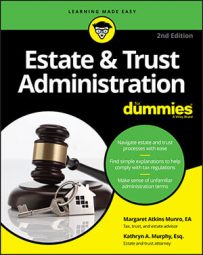Bonds are pieces of loans, packaged by a corporation or a government as an investment product. When you purchase a bond, you’re purchasing a piece of someone else’s debt. In exchange for the money you’re lending, that debtor agrees to pay you interest. Bonds are sometimes referred to as fixed-income securities because the income that they generate for the trust is tied to the stated interest rate on the bond.
When investing in bonds, you’re typically looking to produce a steady stream of income for the income beneficiary. One of most effective ways to achieve that goal is by laddering the maturity dates of the bonds you buy so that bonds mature in sequence, rather than all at once. For example, you may buy one bond that matures in 2013, one in 2014, one in 2015, and so on.
Different income beneficiaries have different needs. Some require as much income as you can squeeze out of the trust’s principal; others want whatever income they receive to be tax exempt. Still others are best served by a combination of approaches. The most common types of bonds and what they can offer both the trust and the beneficiary are as follows:
Corporate: Issued by corporations, these bonds generally carry some of the highest interest rates available. The interest earned is taxable at both the federal and state level.
Foreign: Other countries borrow money, too, and foreign bonds can be very attractive to investors. If you feel so inclined, or your investment advisor thinks that foreign bonds are a good, safe place for some of the trust’s principal, you should consider sticking a toe in this water. What can complicate foreign bonds somewhat is that they’re typically sold in foreign currencies (and pay interest that way, too).
Although your brokerage can handle all the currency exchange issues, your return on investment isn’t just dictated by the stated interest rate (which doesn’t change) but also by currency exchange rates (which do fluctuate). Interest on foreign bonds is taxable at both the federal and state levels.
Municipal: Issued by states, cities, and towns, these bonds carry lower interest rates because they’re exempt from federal income tax, and depending on what state(s) the trust and trust beneficiary pay income tax to, they may also be free from state income tax.
U.S. Government: Not to be confused with U.S. Treasury obligations, U.S. Government bonds are the debts of U.S. governmental agencies, such as GNMA. These bonds typically pay a slightly higher interest rate than U.S. Treasury obligations, but interest from them is income taxable at both the federal and state levels.
U.S. Treasury: The safest of all safe investments, these bonds are backed by the full faith and credit of the U.S. Treasury. In exchange for lending money to the U.S. Treasury, it pays you interest and as an added bonus, the interest is tax exempt in every state.
Just as you may not consider loaning money to your shifty Cousin Norman, you may not want to lend the trust’s money to some corporations or municipalities with reputations for mishandling money or being perpetually in debt. How can you tell? If it seems too good to be true, it probably is; be very wary of bonds that promise extraordinarily high interest rates.
Face it, if the corporation, city, or town could borrow money and pay less interest, wouldn’t they do so? These very high interest rate bonds are sometimes referred to as junk bonds or high-yield bonds. If you’re in a position to venture into this arena, go very carefully. These bonds carry not only a high interest rate but also a high rate of default.
If the bond issuer defaults on the loan, not only do you not get your interest payments, but you also just lost your principal investment.
If you’re not sure about a bond you’re considering purchasing, you may want to check that particular bond’s rating, which is essentially a grade assigned to that bond by the rating agencies. The two major agencies, Standard & Poor’s (S&P) and Moody’s Investor Services, assign ratings when a bond is first issued and then periodically review their ratings based on how the borrower is doing financially.
You can phone Moody’s rating desk at 212-553-0377, or you can access Standard & Poor’s ratings. For both services, you need the bond’s identifying number, a nine-digit alphanumeric identifier called its CUSIP number, in order to check a specific bond. Every publicly traded security has a CUSIP number. If the broker holds the trust’s securities, the CUSIP number appears on the original purchase confirmation or on your statement.
As a result of the Great Recession of 2007–2008, the underlying value of S&P and Moody’s bond ratings has become suspect, with many corporations and municipalities defaulting on loan obligations graded as investment quality or higher. Turns out, the S&P and Moody’s are both supported by fees paid by the companies and municipalities they rate, so what were once thought to be unbiased opinions apparently are not.
By all means, use the S&P and/or Moody’s ratings, but use them with caution and a heavy dollop of good sense. If you’re hearing rumblings that a corporation, or even a country, may be in financial trouble, perhaps that’s not the safest place to invest your trust’s assets.

